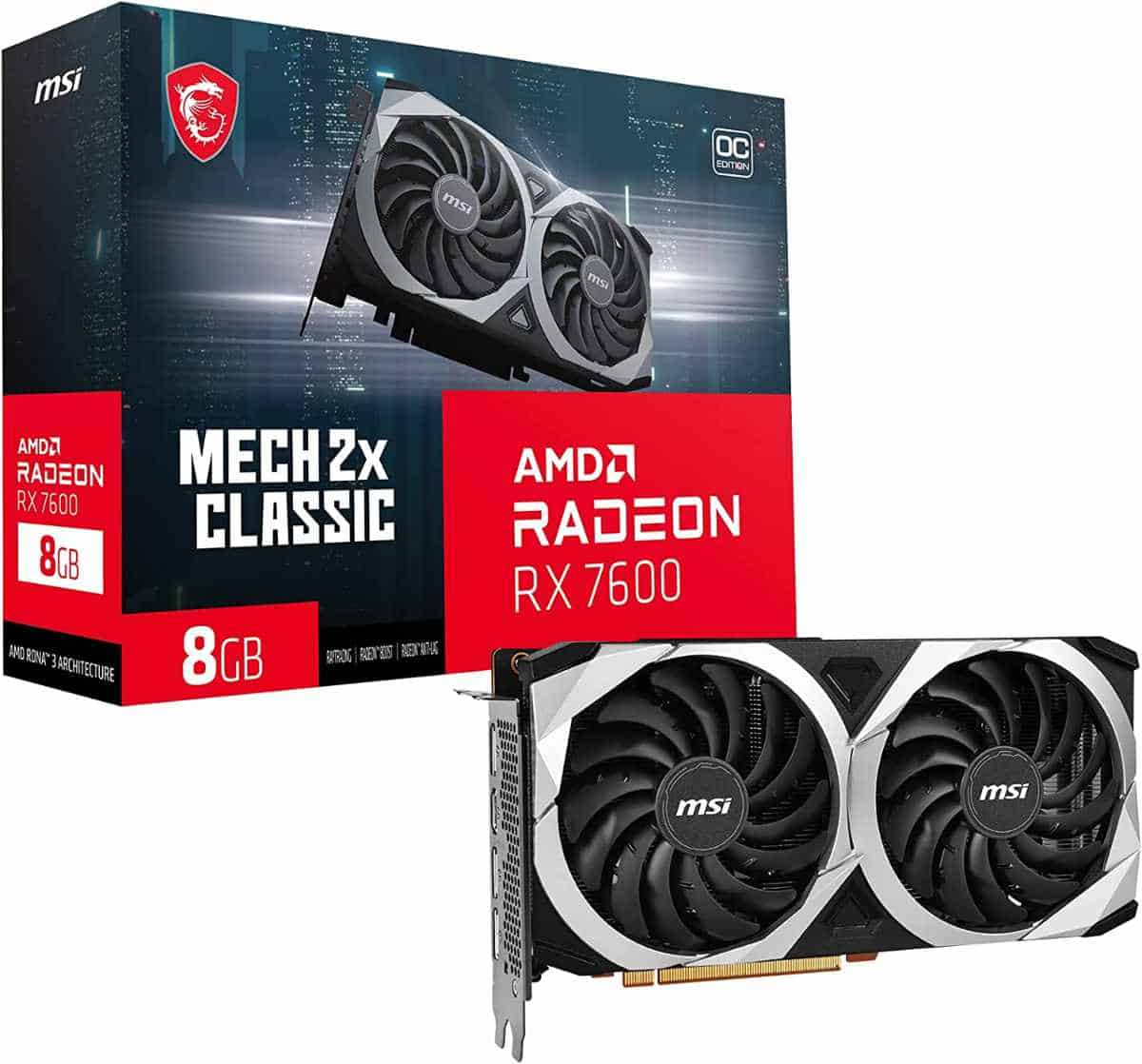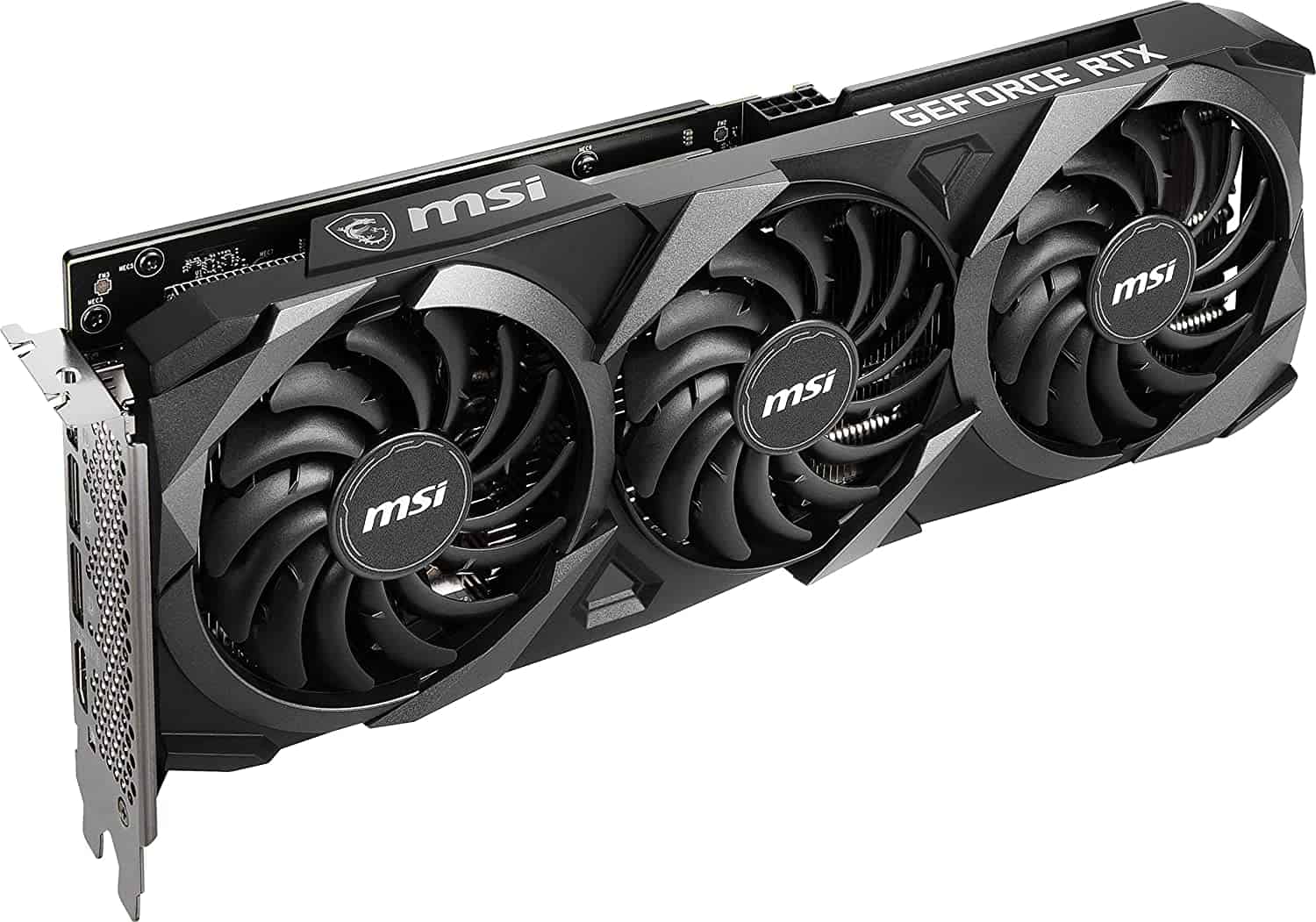
MSI Gaming Radeon RX 7600 Mech 2X

Overclocked model for improved performance offering
Small size able to fit in most cases and avoids any sag
RX 7600 is here, let's see how it performs vs the popular RTX 3060 Ti

WePC is reader-supported. When you buy through links on our site, we may earn an affiliate commission. Prices subject to change. Learn more
Now that the RX 7600 has been officially announced by AMD, and you can go ahead and figure out where to buy it – it’s time to compare RX 7600 vs RTX 3060 Ti. This is yet again a battle of AMD and Nvidia, who still represent the market leaders in the graphics card market. AMD’s choice here is one generation ahead of it’s rival in this case.
The RTX 3060 Ti still remains a massively popular card, especially since the 4060 Ti hasn’t really improved on the performance enough for many 30-series owners. But can the RX 7600 provide a good alternative? Well, let’s find out and see as we compare RX 7600 vs RTX 3060 Ti.


Overclocked model for improved performance offering
Small size able to fit in most cases and avoids any sag

Stylish, gaming aesthetics
Strong materials and build design
High-end cooling solution
On the expensive side
The first thing we actually want to talk about is the different architecture of these two GPUs. We’re comparing rival companies, so they’re of course using different architecture for their graphics cards. There is also a difference in generation between them as we previously mentioned. The Navi III RX 7000 series vs the GeForce 30-series.
Nvidia’s RTX cards have always performed better with ray tracing, and this is still the case. RDNA 3 has improved in this area however, but we’d say the 30-series is still leading in this regard. You’ll see this in the specs below with the 3060 Ti still having more RT cores included.
Specs really do tell the story in many cases, so it’s important to do comparison beyond the architecture. See the comparison table just below.
| RX 7600 | RTX 3060 Ti | |
|---|---|---|
| GPU | Navi 33 XL | GA104-200-A1 |
| Shaders | 2,048 | 4,864 |
| RT cores | 32 | 38 |
| TMUs | 128 | 152 |
| Memory (VRAM) | 8GB GDDR6 | 8GB GDDR6 |
| Base clock speed | 1720 MHz | 1,410 MHz |
| Boost clock speed | 2625 MHz | 1,665 MHz |
| Memory clock | 18 Gbps | 14 Gbps |
| Memory bus width | 128-bit | 256-bit |
| Card bus interface | PCIe 4.0 x8 | PCIe 4.0 x16 |
| Memory bandwidth | 288 GB/s | 448 GB/s |
| TDP | 165W | 200W |
Overall, we’d say the RTX 3060 Ti still holds it’s own. We can see that the 3060 Ti is more powerful, despite it’s lower clock speeds. Benchmarks prove that Nvidia’s choice in this case is the better performing card. Some of the key specs making a difference here include the memory bandwidth and shaders.
Let’s break that down in more detail.
As you can see, the older RTX 3060 Ti features more than double the number of shaders we see in the RX 7600. Shaders are used for processing the graphics, therefore having a higher number theoretically means more power and efficiency overall. There is an important difference though, as the rivalling companies use different tech to power their GPUs. Nvidia have CUDA Cores, and AMD have their stream processors equivalent.
These two technologies do work differently, so it’s hard to compare them 1:1. It’s true that there’s more than double the shaders, but that doesn’t flat out mean the performance is doubled, but the difference is clearly noticeable.
Now on to frequency. What we’re talking about here is the clock rates of the GPUs. This is where the RX 7600 comes out on top according to the specs, and you would expect that from a more modern GPU. The option for overclocking is always present though if you want to up the frequency. Clock speed does make a difference, but the RTX 3060 Ti earns it’s performance over the RX 7600 from other aspects.
VRAM (aka video memory) is a hotly discussed topic these days, especially when it comes to these mid-range cards. Information such as images and graphics is stored within the VRAM. Having access to more VRAM is vital for enjoying games smoothly at higher resolutions, because more information for textures (for example) can be stored at any given time.
As we can see from the specs, both cards feature 8GB GDDR6 VRAM. This means you could probably expect them to perform comparatively at different resolutions. However, there are some important differences. The RX 7600 only has a 128-bit memory bus with 288 GB/s bandwidth, while the RTX 3060 Ti boasts 256-bit with 448 GB/s. Although they have the exact same VRAM, the additional memory specs give the RTX 3060 Ti the edge at 1440p, while the RX 7600 cements itself as a 1080p GPU solely.
This is another area were the RX 7600. While the stripped down memory specs for the RX 7600 are pretty cost-cutting, this looks to have a positive effect on the TDP too. GPUs are getting more efficient overall regardless, and the generation difference here shows. Lower TDP (Thermal Design Power) means the card is better at negating high temperatures. This means cooler running temp and better efficiency.
The RTX 3060 Ti has 200W TDP, while the RX 7600 has just 165W, this has a direct effect on the suggested PSU too – 3060 Ti with 550W, and RX 7600 with 450W. So if you’re looking to run a cooler system overall, AMD’s choice here looks to be the winner.
The performance of these two cards does differ, and you can expect that from checking out the specs alone. Although they share some similarities, the jump up to Ti in the 3060’s case makes a difference. That difference marks a noticeable improvement, leaving the RTX 3060 Ti as the winner in regards to raw performance.
AMD’s RX 7600 is aimed at 1080p gaming. So is the RTX 3060 Ti to a certain extent, but it’s also more capable at 1440p due it’s increased memory bandwidth as we discussed. Both are good picks for 1080p though, which is the best way of compare these two.
When it comes to benchmarking, we want to see how much FPS (frames per second) we can get in our favorite games. There have been plenty of benchmarks released with reviews on the day prior to the launch of the RX 7600, so we can see how it compares directly up against the RTX 3060 Ti. An average FPS was taken for the final result.
| RX 7600 | RTX 3060 Ti | |
|---|---|---|
| Fortnite (1080p) Epic quality | 90 FPS | 123 FPS |
| Fortnite (1440p) Epic quality | 64 FPS | 90 FPS |
| CoD MW2 Multiplayer (1080p) Ultra quality | 123 FPS | 100 FPS |
| CoD MW2 Multiplayer (1080p) Ultra quality | 76 FPS | 70 FPS |
| F1 22 (1080p) Ultra high quality | 81 FPS | 98 FPS |
| F1 22 (1440p) Ultra high quality | 53 FPS | 62 FPS |
| Cyberpunk 2077 (1080p) High quality | 86 FPS | 95 FPS |
| Cyberpunk 2077 (1440p) High quality | 55 FPS | 61 FPS |
Interestingly enough, one game which enjoys higher framerate for the RX 7600 GPU is Call of Duty: Modern Warfare 2. This is thanks to the fantastic optimization in that game for RDNA 3 GPUs. As you can see, there are plenty of factors at play here.
Now it’s time for our price comparison between the RX 7600 and RTX 3060 Ti. Let’s jump straight into the details.
As you can see, the two cards obviously have a stark difference in price. $130 between them. Saying that, the RTX 3060 Ti is an older GPU, so it may be more susceptible to a deal striking there every now and again. Likewise, it will be easier to source one second-hand for cheap if you wish to do so.
The RTX 3060 Ti is definitely more powerful overall, but as benchmarks show, the newer-generation RDNA 3 choice is close, and support for the architecture will only be boosted moving forward – which could result in better framerates later down the line. This means the MSRP comparison looks pretty good for the RX 7600 as a budget 1080p GPU.
Picking a best generally requires taking in your specific wants and needs into account. If you’re looking for a card which is newer and better for your budget, then the RX 7600 is no doubt the winner. You may be able to shop around a little more with the RTX 3060 Ti though, so always be on the lookout for deals. At 1440p, the RTX 3060 Ti is the right choice between these two. However, jumping up to a higher resolution like this may be better suited for even more powerful GPUs.
We mentioned budget already, but the RX 7600 is a good option if you want a more efficient cheaper gaming rig overall. If you don’t have the recommended power supply or have cheaper cooling solutions already installed, the RTX 3060 Ti will be seeing higher temperatures than the RX 7600 in many cases. Overall, picking a winner is tough, but the RX 7600 is a tempting choice over the popular RTX 3060 Ti.
Yes, the RX 7600 released on May 25th, 2023. The RTX 3060 Ti belongs to an older generation of graphics cards, and saw it’s release date back in October 2020, with multiple revisions following.
Nvidia GPUs have long been the more popular choice, especially thanks to their performance with ray tracing and DLSS technologies. However, AMD graphics cards are a good alternative – and they’ve caught up in recent years.